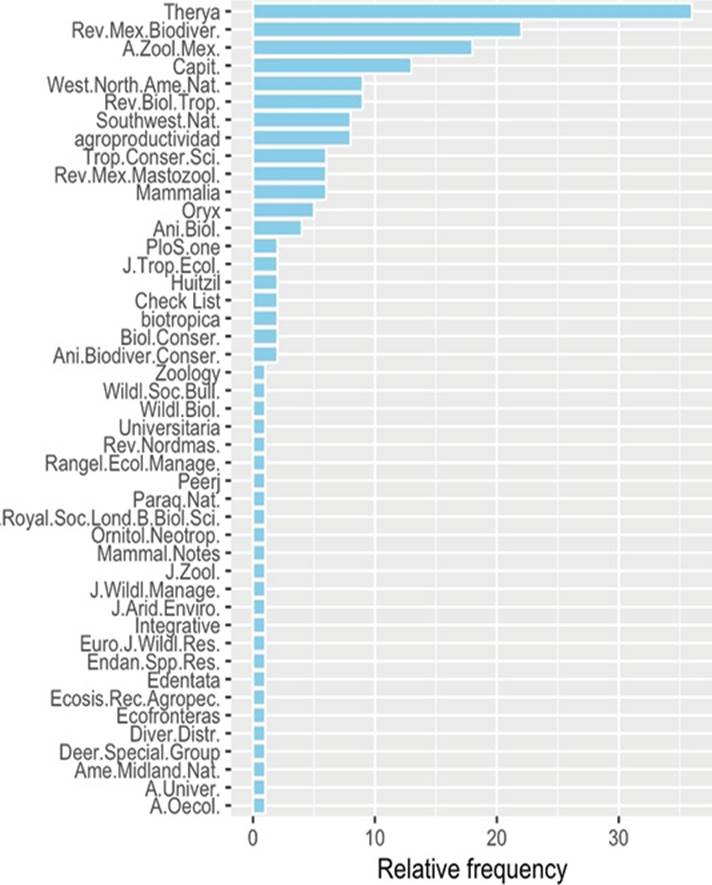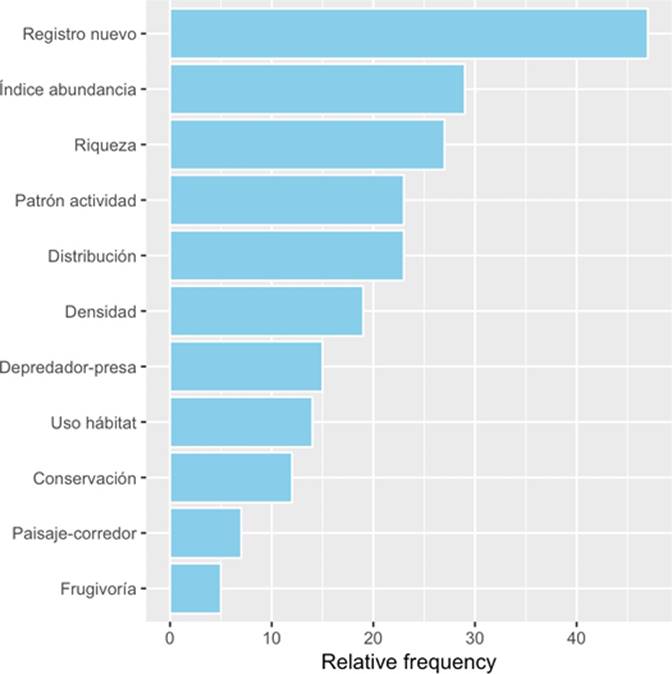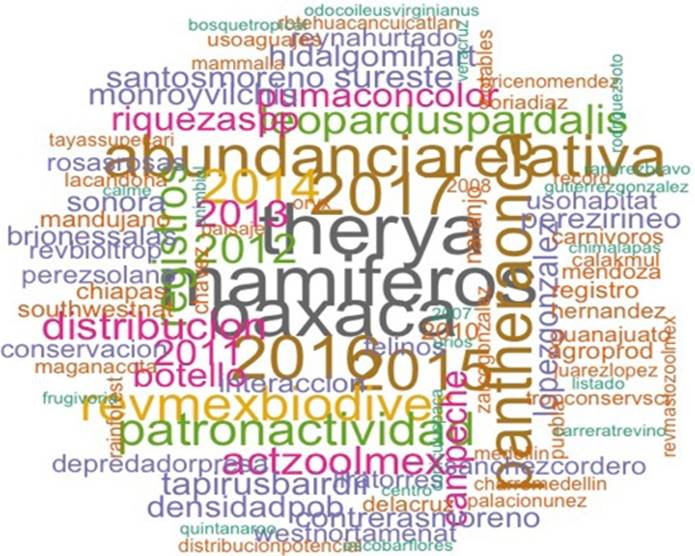Introduction
The monitoring of biodiversity, in either different regions or a single region through time, requires collecting data on many species, often across different taxonomic groups and trophic levels, and with different life histories and other parameters that add complexity to the investigation (O’Brien et al. 2010). In particular, inventories serve a number of purposes, such as determining the ecological diversity in a given site, making comparisons between sites, refining distribution maps for individual species, obtaining demographic parameters on populations, or assessing the impact of human activities on mammal communities (Baillie et al. 2008). An in-depth knowledge of the fauna supports the development and planning of improved conservation strategies, particularly in protected natural areas (Bruner et al. 2001). In this sense, birds and medium-sized and large mammals are considered to be key groups to monitor biodiversity and the state of ecological integrity (Ahumada et al. 2011).
One of the most popular techniques to survey the fauna is based on cameras-traps, also called photo-trapping (Meek and Pittet 2012, McCallum 2013, Burton et al. 2015, Rowcliffe 2017). This is due, among several factors, to the improvement in technological development and the lower costs of the equipment involved (Rovero et al. 2013). The applications of this technique range from data collection for species inventories, the study of activity patterns, estimates of occupancy, the relative abundance and density of animals, up to more specific aspects such as behavior and interactions between species and their habitat, among other topics (Jenks et al. 2011). Photographs provide reliable records about the presence of species, and can be shared for verification by experts (O’Connell et al. 2010). The use and development of photo-trapping has been so successful that several books and manuals studies addressing it have been published in just a few years (O’Connell et al. 2010, Fleming et al. 2014, Rovero and Zimmermann, 2016, Wearn and Glover-Kapfer 2017). In Mexico, the use of camera traps has boomed, mainly in the past decade, being applied to several species with various objectives in different regions and habitats across the country. Hence, the trends and contributions of this technology to the knowledge of the fauna is a topic worth investigating.
One way to measure the overall and particular trends in the use of photo-trapping is data mining (text mining), as this approach facilitates the methodical analysis of large volumes of data. Specifically, text mining is the process of extracting information from a set of texts (Kwartler 2017). The results are displayed as tables and graphs that can be useful for multiple purposes (Silge and Robinson 2017). In a scientific context, for instance, text mining may contribute to a relatively rapid analytical processing of extensive information. Although text mining may not be a fully automated process in itself, the different computation tools currently available enable the processing of large amounts of text over a relatively short time. In particular, several packages have been developed for the R platform that are useful to analyze this type of information (Kwartler 2017, Silge and Robinson 2017).
The main objective of this work was to gather published studies using photo-trapping as a primary or supplementary method to collect data or records on the presence of species in various locations in Mexico. The specific objectives were: 1) Analyze the temporal trend of studies. 2) Identify the species that are either most frequently studied or for which more information is obtained with this method. 3) Identify the main research groups, highlighting the research leaders. 4) Identify the sites, regions, and natural areas studied. 5) Assess whether the data from photo-trapping are being applied to specific management and conservation issues/solutions, in addition to the generation of scientific knowledge. 6) Suggest further topics in the application of photo-trapping in our country.
Methods
Information gathering. Published information was collected on studies reporting the use of camera-traps as the main or supplementary methodology to get information from a number of animal species. To this end, a comprehensive search of articles cited in the Google Scholar was conducted spanning from 1990 to late 2017. The search was conducted using the key words photo-trapping, camera-traps, monitoring, Mexico, in both Spanish and English. Excluded sources were technical reports, theses and website news. The respective literature references were saved in BibTex format (Mata-Perez 2014). The RefManageR package was used for managing the bibliography in BibTex format (McLean 2014, 2017). Once all the literature references were compiled, these were saved as files with the extension .bib and used as basis for the text mining analysis in R. The quantitative analysis consisted basically in constructing frequency tables for each objective stated in this work using the packages tidyverse (Wickham 2017), tm (Feinerer and Hornik 2017), and ggplot2 (Wickham 2009). The work teams and the interactions between them were determined using the igraph package (Csardi and Nepusz 2006). All analyzes in this study were carried out using R version 3.3.3 (R Core Team 2017) on the RStudio platform (RStudio Team 2015).
Results
Temporal Trend and Journals. A total of 188 articles were gathered: 1 book, 6 book chapters and 181 articles published between 1998 and 2017; 88.2 % of these were published over the past 7 years (Figure 1). These articles were published in 50 journals: 9 national and 41 international journals; 76.1 % were published in the journals Therya, Revista Mexicana de Biodiversidad, Acta Zoológica Mexicana (new series), Revista de Biología Tropical, Western North American Naturalist, The Souhtwestern Naturalist, Agroproductividad, Tropical Conservation Science, Revista Mexicana de Mastozoología, Oryx, Mammalia, and Animal Biology (Figure 2).
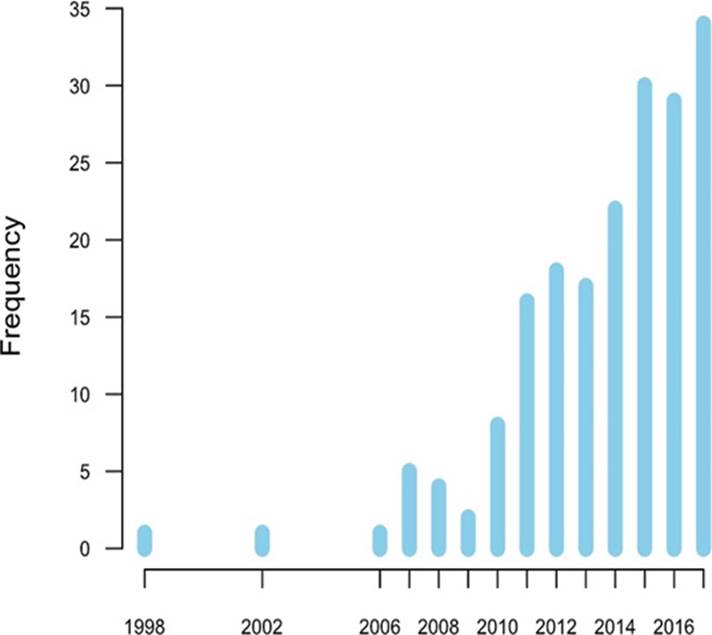
Figure 1 Trend in the number of publications involving the use of photo-trapping to gather data about wildlife in Mexico.
Authors. Articles were written by 406 co-authors from various Mexican and foreign institutions. According to their contribution, 28 authors published 5 or more articles, altogether accounting for 32.4 % of all articles published (Figure 3). This analysis yielded a relatively complex network of interactions between researchers (Figure 4). Research groups with some publications and little interaction with the rest are shown at the periphery of the network. In contrast, several clusters of work teams and their interaction with other groups appear to the center of the network. The major teams identified are: 1) Botello, Sánchez-Cordero, Charre-Medellín. 2) López-González, Lara-Díaz, Coronel-Arellano, Gutiérrez-González. 3) Hidalgo-Mirhart, Contreras-Moreno, de la Cruz, Pérez-Solano. 4) Reyna-Hurtado, Briceño-Méndez, Sandoval-Serés, Sanvicente-López. 5) Monroy-Vilchis, Soria-Díaz, Rodríguez-Soto. 6) Rosas-Rosas, Tarango-Arambula, Clemente-Sánchez, Palacio-Núñez, Hernández- SaintMartín. 7) Lira-Torres (r. i. p.), Briones-Salas. 8) Pérez-Irineo, Santos-Moreno. 9) Chávez, Ceballos. 10) Medellín, de la Torre.
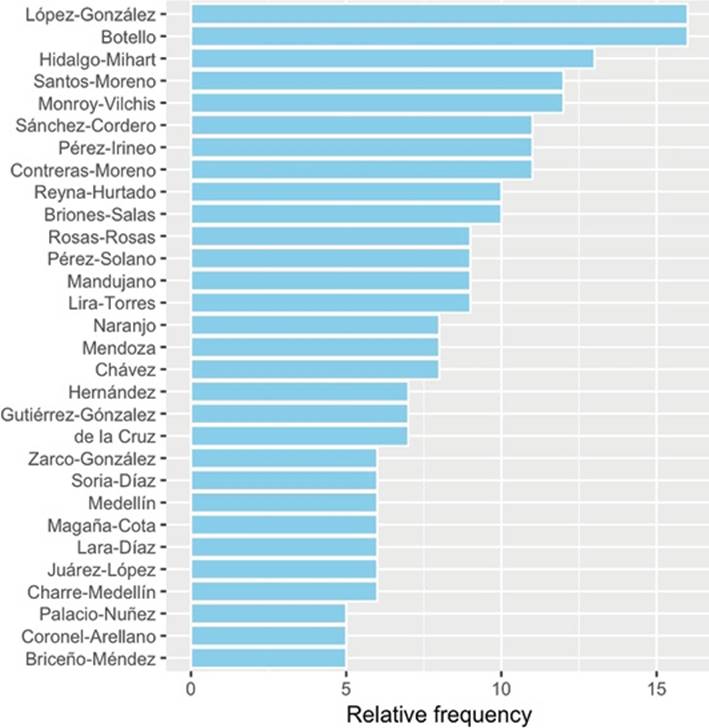
Figure 3 Main authors that have contributed a large number of publications involving photo-trapping in Mexico. Authors who have contributed more than two articles are shown.
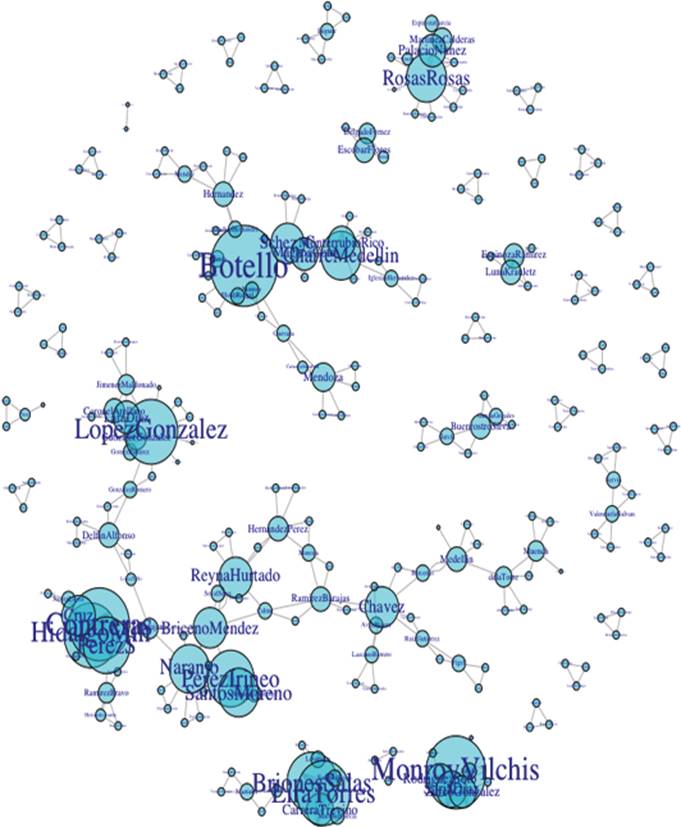
Figure 4 Interactions network between scientists who have used and published works involving photo-trapping in Mexico. The size of letters indicates the number of publications by a given author and the extent of his/her interactions with other co-authors.
Species. A total of 40 species are reported in the title or in the abstract of publications involving photo-trapping, with felines and ungulates as the main groups. Particularly, Panthera onca, Leopardus pardalis, Puma concolor, Tapirus bairdii, Tayassu pecari, Odocoileus virginianus, and Cuniculus paca account for 55.1 % of articles (Figure 5).
Main Topics. Photo-trapping studies cover a diverse range of topics. Most frequently, studies report new records, that is, when a species is recorded photographically in a site for the first time ever (Figure 6). Occasionally, these new records broaden the geographical distribution range. In order of frequency, these are followed by studies that report the number of species (richness) in a particular site or region, and the estimated population size measured as the index of relative abundance (IAR), density, and occupancy, activity patterns, and ecological interactions including predator-prey, frugivory, and parasitism. Also, photo-trapping has served to gather presence data for subsequent modeling of the potential geographic distribution.
Regions, states, and natural areas. The regions with the largest number of studies using trap-cameras are located in the Southeast, followed by the Center; while fewer investigations have been conducted in the North (Figure 7a). In particular, Oaxaca is the state where the largest number of studies with this technology have been conducted, followed by Campeche, Sonora, Chiapas, Guanajuato, and Puebla, altogether accounting for 33.1 % of the total number of published articles (Figure 7b). A fact worth mentioning is that many studies have been carried out within or near Biosphere Reserves, reserve areas and similar zones, such as Tehuacán-Cuicatlán, La Lacandona, Calakmul, Los Chimalapas, Sierra Gorda, Laguna de Terminos, Sierra Norte, the so-called Sky Islands, Nanchichitla, El Cielo, and the Chihuahuan Desert (Figure 7c).
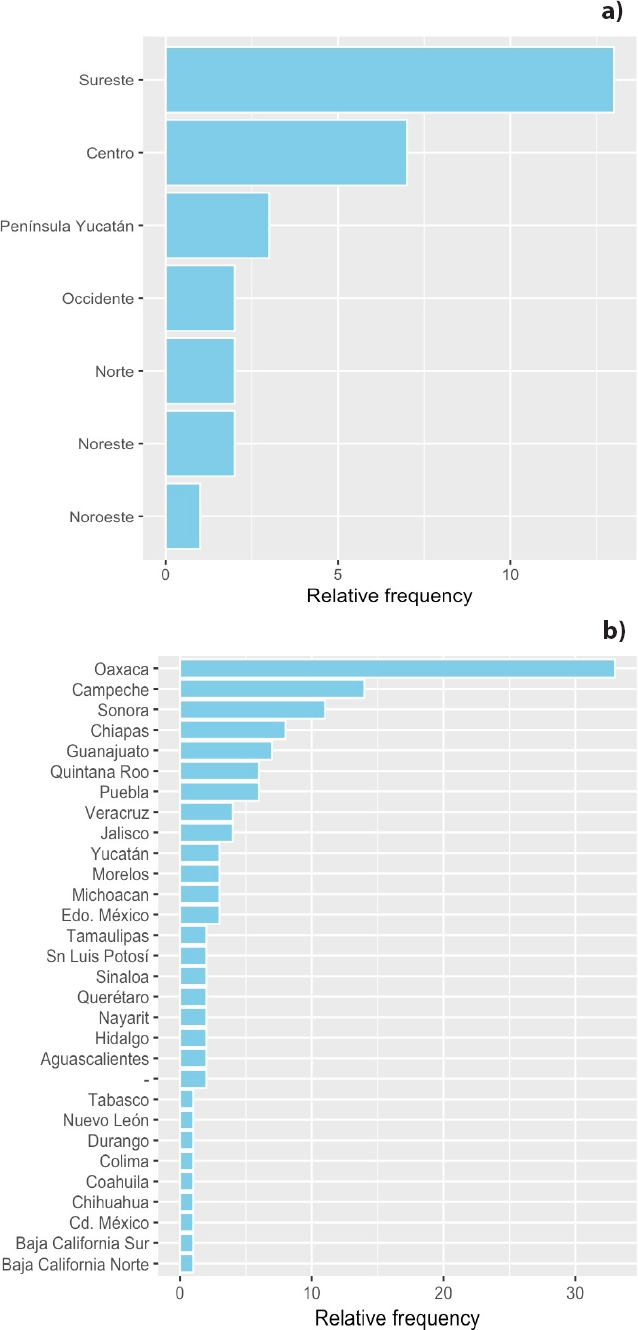
Figura 7 Regions (a), and states (b) , most frequently addressed in studies using photo-trapping in Mexico.
Discussion
The text mining analysis clearly indicates that the use of photo-trapping is on the rise in our country (Figure 8). Although this technique started being used since the late 1980s, it was until 1998 when the first article involving this technology in Mexico was published (Lopez-González et al. 1998). The use of this method escalated during the first decade of this century, and more than 88 % of the works gathered here were published over the past siete years. This increase in the use of photo-trapping in Mexico mirrors the global trend (e. g., Rowcliffe and Carbone 2008). This is due to the fact that there is a growing number of scientists interested in using this technology. The data indicate that publications have been authored by more than 400 researchers; however, considering students, technicians, landowners and other persons that do not publish their findings in journals, this figure is probably even higher. Therefore, the number of published works using this technology is expected to increase significantly in the next few years. Studies using trap-cameras in Mexico have been published in various national and international journals, in addition to some chapters in books, and even in a book/manual addressing practical aspects related to photo-trapping in the field (Chavez et al. 2013). Articles have been published mainly in Mexican scientific journals, a fact that highlights the importance and need to strengthen and project national journals at international levels by including them in high-impact indexes.
When the species referred to in the title or in the abstract of an article are used as the sole inclusion criteria in this analysis, the results clearly indicate that the species most frequently studied include felines (jaguar, ocelot and puma), ungulates (tapir, white-lipped peccary, and white-tailed deer), and several species of the order Carnivora. In particular, the most frequent investigations focus on the jaguar, as this is a charismatic species used as indicator of ecosystem health that is currently endangered (e. g., Chavez et al. 2013). On the other hand, although authors such as Botello et al. (2007) have suggested the use of photo-trapping to gather data for birds and reptiles, in practice it has been used only partially for birds. However, as in other parts of the world (e. g., O’Brien and Kinnaird 2008), the number of published studies is expected to increase, since a number of investigations are ongoing that report the use of this technology to gather data on birds. To note, a single article published in Mexico used photo-trapping to obtain information from seed predation by a mouse (i. e., Chilpa-Galv et al. 2017). This technology is already commonly used in other regions of the world to survey small mammals. As regards reptiles, no published studies were found involving the use of camera-traps, unlike other countries where this technique is already in use for highly conspicuous species (e. g., Bennet and Clements 2014). Although photo-trapping is an appealing technology, for many groups of animals it is not entirely suitable, as in the case of small mammals like rodents, bats, arboreal mammals, passeriform birds, and reptiles (McCallum, 2013, Rowcliffe 2017). For these taxonomic groups, the use of other methods remains as the best alternative; in this regard, camera-traps will only be a supplementary method, as shown by many of the works analyzed and cited herein. In addition, a high proportion of data have been obtained from sampling with cameras placed very close to the ground. This is worth stressing, as an important group of mammals and birds are arboreal; therefore, sampling designs that are suitable for this group of animals are required in their habitats (e. g., Gregory et al. 2014). Although no published work addressing this issue was identified, a number of field investigations of arboreal mammals involving camera-traps in Mexico are ongoing.
Similar to other countries, photo-trapping has been used in Mexico to investigate a range of aspects about the biology of animal species. In terms of the number of works, the main topic of interest deals with new records of species in sites where there their presence had not been previously reported; a topic closely related to new records is the broadening of the geographic range. Likewise, photo-trapping is being used to record the presence of species as supplementary data for modeling the potential distribution range using the ecological niche theory as conceptual framework — a conceptual and methodological approach commonly used today. Another aspect frequently addressed is the study of species richness and diversity. In many cases, photo-trapping is employed as the only method to report species richness, particularly in the case of medium-sized and large species, which are the species most easily detected with this technique. Other studies have applied photo-trapping as a supplementary method along with traps, nets and traces, to elaborate lists of species in certain sites. In other words, photo-trapping is a key method in Mexico for broadening and contributing to the knowledge of biodiversity and distribution of animal species, mainly medium-sized and large mammals which, given their habits and rarity, are often hard to spot and for which data gathering is difficult when other sampling methods are used (Thompson 2013). Finally, some practical aspects worth stressing are, on the one hand, the systematization of images obtained by photo-trapping in record cards filed in Scientific Collections, which are key for the knowledge of diversity; on the other, the development and training in different techniques and methods of analysis associated with photo-trapping (Botello et al. 2007).
The study of population size, particularly the use of the so-called indices of relative abundance (IAR), is a topic frequently addressed in photo-trapping studies. Related to population size estimates, some works have focused on density through classical capture-recapture and, more recently, the so-called spatially explicit capture-recapture methods. In contrast, few studies have focused on estimating occupancy. Separately, numerical and statistical methods employed to analyze photo-trapping data have covered various approaches, ranging from the absolute subjective interpretation of the so-called indices of relative abundance (IAR) to very robust methods of analysis (Springer et al. 2012). The text mining analysis indicates that the IAR is still extensively used in our country despite its serious limitations (Sollmann et al. 2013).
In this respect, users of camera-traps in our country should apply a high statistical rigor in their analysis. Fortunately, the publication of works that estimate population size through capture-recapture and even spatially explicit methods is on the rise (e. g., Carbajal-Borges et al. 2014). These models require the recognition of individuals. When individual identification is not possible, there are several alternatives; one is the use of occupancy models (e. g., Cove et al. 2013) and the use of models that estimate density without the need to recognize individuals (e. g., Rowcliffe et al. 2014, Cusack et al. 2015, Rowcliffe et al. 2016). Also, the application of traditional distance-based methods (Thomas et al. 2010) for photo-trapping data is increasing (Rowcliffe et al. 2011, Howe et al. 2017). Another area of opportunity offered by camera-traps is video recording (Delgado-V. et al. 2011, McCallum, 2013, Rowcliffe 2017).
Camera-traps can record the time, temperature, moon phase and other data simultaneously with each image. This has the use of this technology to estimate the patterns of activity and the overlap of these patterns between species. In addition, photo-trapping has been used to analyze the use of the habitat. Although this application is not common yet, photo-trapping can be used to gather physiological information, in particular regarding reproduction (e. g., Aranda et al. 2012). Ecological interactions is another topic of growing interest, especially for predation-prey interactions, frugivory, and parasitism, through functional ecological (Soria-Díaz et al. 2017a, 2017b) and experimental (Camargo-Sanabria et al. 2015) approaches. In addition, photo-trapping studies are addressing not only the distribution and abundance of species, but also other aspects related to conservation, such as hunting, habitat fragmentation, and livestock raising, as well as the effect of hurricanes, landscape management and connectivity (e. g., Lara-Díaz et al. 2013). In other words, photo-trapping is yielding very interesting findings on a number of topics related to behavior, interactions, and management.
Although camera-traps are being used across the country, data mining clearly evidenced that the majority of studies have been conducted in the Southeast region. In particular, Oaxaca stands out as the state with the largest number of published studies involving photo-trapping. Next in importance are Campeche, Chiapas, Quintana Roo, and Yucatan. In the center of the country, the states that yielded the largest number of publications are Guanajuato, Puebla, Veracruz, Michoacán and Jalisco. In the north, the state of Sonora is worth mentioning. Separately, a significant percentage of studies involving photo-trapping have been conducted in Protected Natural Areas, mainly Biosphere Reserves such as Tehuacán-Cuicatlán, La Lacandona, Calakmul, Los Chimalapas, Sierra Gorda, Laguna de Terminos, and Sierra Norte. The biosphere reserves share a vision of the integration of the various uses of resources consistent with the long-term conservation of biological and cultural diversity, under a land-use scheme based on core, buffer and transition zones. According to Halffter (2011), some reserves are associated with laboratories or institutions that have been pivotal research centers, producing abundant and important knowledge. In this sense, in addition to their key role in the creation of knowledge and prevention of changes of land use (Figueroa and Sánchez-Cordero 2008), ANPs frequently offer adequate conditions of personal safety and equipment used in photo-trapping studies.
In Mexico, there are initiatives for the application of photograph collection and monitoring protocols at the country level, such as the biological photograph collection of UNAM (Botello et al. 2007), as well as programs promoted by the National Forestry Commission (CONAFOR) and the National Commission of Protected Areas (CONANP). There are also local and regional initiatives for the monitoring of wild animals using trap-cameras, such as the Community Monitoring of Biodiversity in Oaxaca, an appealing initiative that includes a user-friendly webpage (http://dsjm-conanp-monitoreo.org). Another example is the Proyecto Guerrero Jaguar social initiative for the monitoring of wildlife in the state of Guerrero (http://www.facebook.com/guerrerojaguar). In addition, monitoring programs of key species for conservation have been in place for several years; an example is the jaguar, a species for which photo-trapping has been a core method (Chávez et al. 2013). Likewise, meetings such as the First Meeting of Photo-Trapping Experts in Mexico organized by the National Commission for the Knowledge and Sustainable Use of Biodiversity (CONABIO) have as a key objective to integrate the information obtained from individual studies and programs involving photo-trapping. As a result, progress has been made in having monitoring protocols in place and, to the extent possible, homogenize data collection to facilitate comparisons between regions.











 text new page (beta)
text new page (beta)

